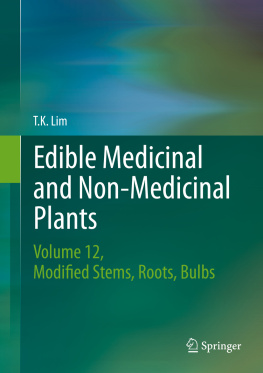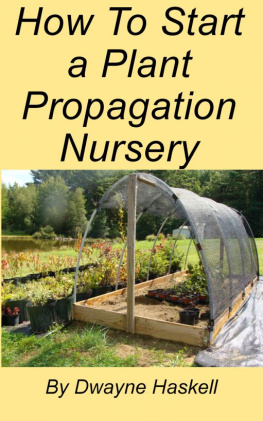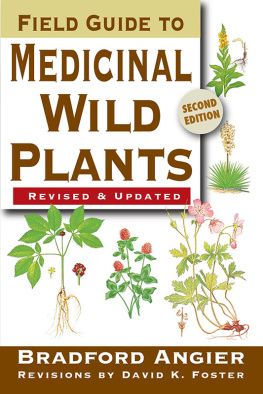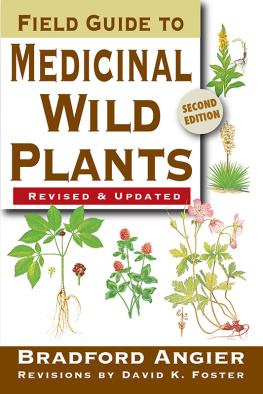Indian Medicinal Plants
Indian Medicinal Plants
Uses and Propagation Aspects
Srinath Rao Akula Ramakrishna

First edition published 2021
by CRC Press
6000 Broken Sound Parkway NW, Suite 300, Boca Raton, FL 33487-2742
and by CRC Press
2 Park Square, Milton Park, Abingdon, Oxon, OX14 4RN
2021 Taylor & Francis Group, LLC
CRC Press is an imprint of Taylor & Francis Group, LLC
Reasonable efforts have been made to publish reliable data and information, but the author and publisher cannot assume responsibility for the validity of all materials or the consequences of their use. The authors and publishers have attempted to trace the copyright holders of all material reproduced in this publication and apologize to copyright holders if permission to publish in this form has not been obtained. If any copyright material has not been acknowledged please write and let us know so we may rectify in any future reprint.
Except as permitted under U.S. Copyright Law, no part of this book may be reprinted, reproduced, transmitted, or utilized in any form by any electronic, mechanical, or other means, now known or hereafter invented, including photocopying, microfilming, and recording, or in any information storage or retrieval system, without written permission from the publishers.
For permission to photocopy or use material electronically from this work, access www.copyright.com or contact the Copyright Clearance Center, Inc. (CCC), 222 Rosewood Drive, Danvers, MA 01923, 978-750-8400. For works that are not available on CCC please contact mpkbookspermissions@tandf.co.uk
Trademark notice : Product or corporate names may be trademarks or registered trademarks, and are used only for identification and explanation without intent to infringe.
ISBN: 978-0-367-43214-0 (hbk)
ISBN: 978-1-003-00189-8 (ebk)
Typeset in Times
by Deanta Global Publishing Services, Chennai, India
Contents
The traditional systems of India, namely the Ayurveda and Siddha systems of medicine, have contributed enormously to the branch of medicinal botany. The earliest records of the use of medicinal plants, primarily herbs, in the prevention and cure of diseases in India are found in Vedic literature, and precisely in the Rigveda , which is believed to have been written between 3500 and 1800 BC. In India, several premier institutions, such as the Council of Scientific and Industrial Research (CSIR), New Delhi; the Central Drug Research Institute (CDRI), Lucknow; the Botanical Survey of India (BSI), Kolkata; and the Tropical Botanical Garden and Research Institute (TBGRI), have made considerable efforts to gather information on medicinal plants from different parts of the country. The World Health Organization (WHO) estimated that 80 % of the people in the developing countries of the world rely on traditional medicine for their primary health care needs and about 85 % of traditional medicine involves the use of plants.
The demand for medicinal plants is increasing, and this leads to unscrupulous collection from the wild and adulteration of supplies. Providing high-quality planting material for sustainable use and thereby saving the genetic diversity of plants in the wild is important. In this regard, the in-vitro methods of propagation of some important medicinal plants are provided along with the traditional methods of propagation, which is a highlight of this book. We use the Bentham and Hooker system of classification (proposed between July 1862 and April 1863) in this book. Though this system is not very natural, it is very easy to apply in the field for the identification of plants. Its emphasis on dividing Dicotyledons in to polypetalae, gamopetalae, and monochlamydeae (Incompletae) nature of flowers is very helpful in the identification of plants. It is the best and most accepted system and is still followed in several herbaria globally and in India.
This unique compendium offers the profiles of 274 medicinal plant species with detailed taxonomic classification based on the Bentham and Hooker system of classification. The book also gives the distribution, detailed description and popular nomenclature in Bengali, English, Gujarati, Hindi, Malayalam, Marathi, Sanskrit, Tamil and Telugu. Moreover, it lists the properties, uses, parts used and chemical constituents of the plants. This volume will be of special interest to practitioners of alternative medicine, students of Ayurveda, researchers and industrialists associated with medical botany, pharmacologists, sociologists and medical herbalists.
Prof Srinath Rao
Dr Akula Ramakrishna
We are grateful to Renu Upadhyay, assistant commissioning editor, Jyotsna Jangra, editorial assistant and Todd Perry, production editor of the CRC Press/Taylor & Francis Group team, and also Andrew Corrgian, project manager, from Deanta Global for their help in producing this volume in a beautiful and appealing manner. The authors are thankful to Dr Kotresh, Dr Milind Girdhari, Dr Vedavyas Kulkarni, Dr R.S. Modi and Dr Chandralekha CT for providing photographs of medicinal plants for publication in the book. Prof Srinath Rao is thankful to the then vice-chancellor E.T Puttaiaha and registrar S.L. Hiremath of Gulbarga University Kalburgi, Karnataka State, India for sanctioning one year sabbatical leave for the purpose of writing this book. He is also thankful to Prof V.S. Raju professor of Botany (Taxonomy) (retired), Kakatiya University Warangal, Telengana State, India for the identification of plants and for making corrections in the manuscript. The authors are thankful to their families who have encouraged them to take up this task, permitting them to take the time off to complete it. We are also thankful to our friends and academic colleagues for their support in the successful accomplishment of this book.
Prof Srinath Rao
Dr Akula Ramakrishna
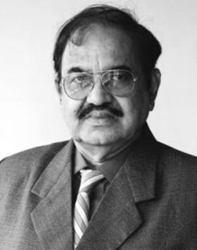
Prof Srinath Rao is a retired professor from the Department of Botany, Gulbarga University, Kalburgi, Karnataka, India. For 34 years, he taught post-graduate students of Botany and Biotechnology in the field of in-vitro propagation of medicinal plants and in-vitro enhancement of secondary metabolites. He has successfully guided 25 M.Phil. and 27 Ph.D. students. He has made significant contributions to in-vitro propagation and enhancement of secondary metabolites in some important medicinal plants. He has presented papers in several international conferences held in the USA, UK, Germany, France and Sri Lanka. Apart from this, he has given 50 invited lectures at national and international conferences. He published more than 100 research papers in national and international journals. He has completed 7 major research projects funded by UGC, CSIR and DST.

Dr Akula Ramakrishna is currently a scientist at Bayer Crop Science, Bangalore, India. Dr Ramakrishna holds a masters degree from the Sri Krishna Devaraya University, Anantapur, Andhra Pradesh, India. He obtained his Ph. D in Biochemistry from the University of Mysore, CSIR-CFTRI, Mysuru. He is a senior research fellow of CSIR, New Delhi. He is involved in various research fields such as Plant Biotechnology, Biochemistry, Plant Secondary Metabolites, Food Science and Technology and Vegetable Quality Analytics. He has published several research papers in leading international journals as well as books, reviews and book chapters. He is also serving as editorial board member and reviewer for reputed international journals. Dr Ramakrishna has presented over 20 research papers in symposia in India and abroad, as well as at some invited lectures in India. He attended the Fifth International Symposium on Plant Neurobiology held in 2009 in Florence, Italy. He also attended the Technical Community of Monsanto (TCM) held in 2016 in St Louis, Missouri. He is a member of the Indian Science Congress Association and Society for Biotechnologists (India). He is a fellow of the Society for Applied Biotechnology, India (2012), and a recipient of the Global Vegetable Research Excellence Award (2017), Global Technology Recognition (2014), Rapid Recognition Award (2013) and Special Recognition (2017) from the Monsanto Company.




